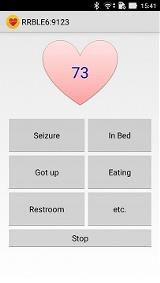Views of Patients With Epilepsy on Wearable Seizure Prediction System Based on Heart Rate Variability
Abstract number :
1.083
Submission category :
2. Translational Research / 2B. Devices, Technologies, Stem Cells
Year :
2018
Submission ID :
498511
Source :
www.aesnet.org
Presentation date :
12/1/2018 6:00:00 PM
Published date :
Nov 5, 2018, 18:00 PM
Authors :
Miho Miyajima, Tokyo Medical and Dental University; Toshitaka Yamakawa, Kumamoto University; Koichi Fujiwara, Kyoto University; Yoko Suzuki, Tsukuba University; Masako Watanabe, Shinjuku Neuro Clinic; Manabu Kano, Kyoto University; and Taketoshi Maehara,
Rationale: The development of an epileptic seizure prediction/alert system could improve quality of life in patients with intractable epilepsy. A seizure can be detected before its clinical onset by monitoring heart rate variability (HRV) alteration. We developed a wearable HRV-based epileptic seizure prediction system integrating HRV analysis and an anomaly monitoring technique [1] in a wearable HRV telemetry system [2]. We report patients’ views on the practical implementation of our HRV-based wearable seizure prediction system. Methods: Fifteen outpatients with epilepsy participated in the practical implementation test of the wearable prediction system prototype, which consists of a wearable HRV sensor with patch electrodes and a smartphone with the original seizure prediction app. The participants were asked to complete a questionnaire designed to assess their views on the usability of the current system and requirements for future ones. The study was approved by the ethics committees of Tokyo Medical and Dental University. Results: Fourteen participants (93%) completed the survey. On usability, 78.6% of them did not complain of any significant discomfort or inconvenience. Similarly, 78.6% indicated satisfaction with the battery life. Most subjects maintained quality of sleep and social activity, whereas 21.4% reported a sense of feeling bad. Feedback regarding device simplicity varied considerably. Approximately two-thirds of the patients developed a mild rash or skin irritation at the site where the electrodes were placed. In terms of future use of the system, 42.9% of the participants were interested in continuous use. The most common reason was prevention of accidents or injuries by seizure (78.6%). Nearly half (42.9%) of the participants expected that system use would reduce their and their caregivers’ anxiety. Regarding the time window for seizure prediction, 78.6% of the participants preferred about 10 minutes (5–10 minutes / 1–3 minutes / 10–30 seconds); none would accept more than one hour. The acceptable cost was 10,000 JPY for the initial cost and 5,000 JPY per month for the running cost. Most participants considered 12 hours of daily operation of the system acceptable. Conclusions: The basic usability of the prediction system was deemed acceptable; its negative effect on sleep or mood was minimal. To avoid skin reaction from the electrode patch, a garment-type sensor with textile electrode would be favorable. Regarding the performance of the seizure prediction algorithm, the seizure occurrence period from the alarm point should be less than 10 minutes.References[1] Yamakawa T, Matsumoto G, and Aoki T. A low-cost long-life R-R interval telemeter with automatic gain control for various ECG amplitudes. Journal of Advanced Research in Physics. 2012;3(1):4 (available online). [2] Fujiwara K, Miyajima M, Yamakawa T, et al. Epileptic seizure prediction based on multivariate statistical process control of heart rate variability features. IEEE Transactions on Biomedical Engineering. 2016;63(6):1321-3132. Funding: This work was supported by JSPS KAKENHI 25282175, SEI Group CSR Foundation, Japan Prize Foundation, The Mitsubishi Foundation, The Japan Epilepsy Research Foundation, and the Japan Agency for Medical Research and Development.
